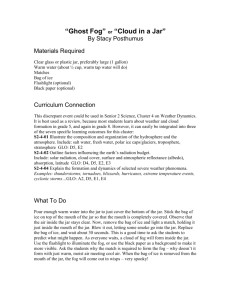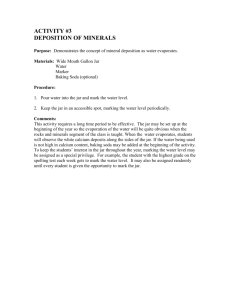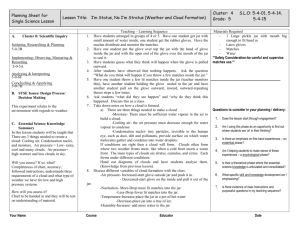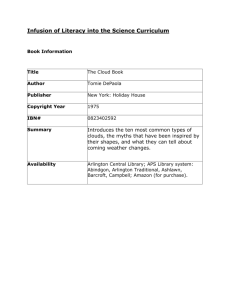Cloud-In-A - Jeffers Foundation
advertisement
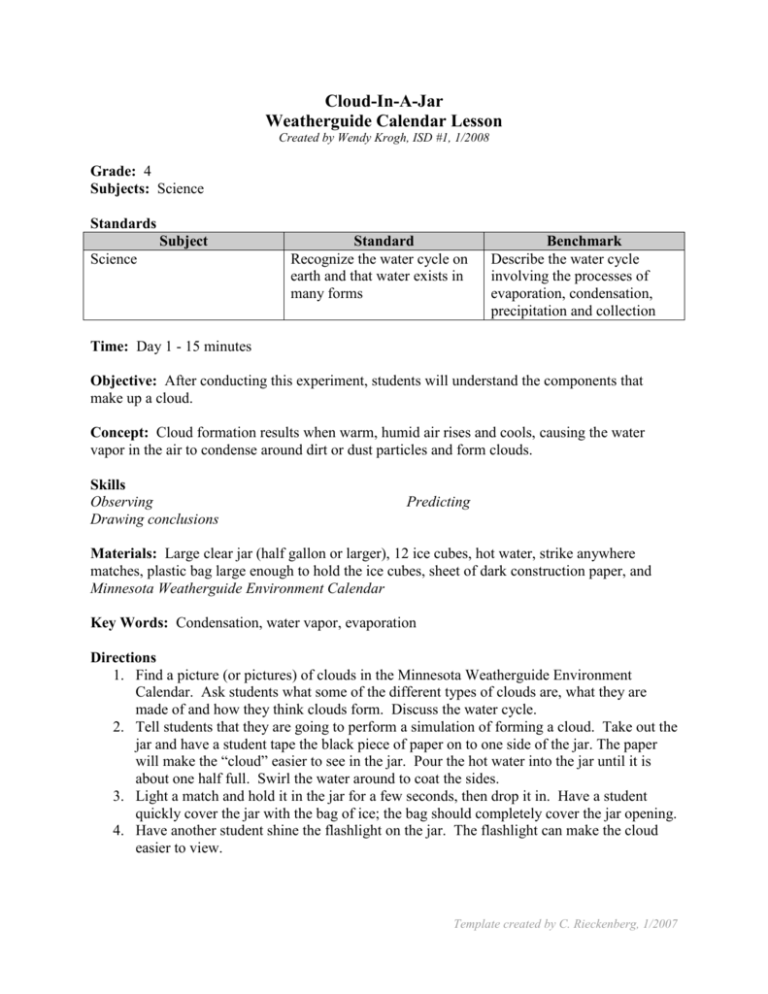
Cloud-In-A-Jar Weatherguide Calendar Lesson Created by Wendy Krogh, ISD #1, 1/2008 Grade: 4 Subjects: Science Standards Subject Science Standard Recognize the water cycle on earth and that water exists in many forms Benchmark Describe the water cycle involving the processes of evaporation, condensation, precipitation and collection Time: Day 1 - 15 minutes Objective: After conducting this experiment, students will understand the components that make up a cloud. Concept: Cloud formation results when warm, humid air rises and cools, causing the water vapor in the air to condense around dirt or dust particles and form clouds. Skills Observing Drawing conclusions Predicting Materials: Large clear jar (half gallon or larger), 12 ice cubes, hot water, strike anywhere matches, plastic bag large enough to hold the ice cubes, sheet of dark construction paper, and Minnesota Weatherguide Environment Calendar Key Words: Condensation, water vapor, evaporation Directions 1. Find a picture (or pictures) of clouds in the Minnesota Weatherguide Environment Calendar. Ask students what some of the different types of clouds are, what they are made of and how they think clouds form. Discuss the water cycle. 2. Tell students that they are going to perform a simulation of forming a cloud. Take out the jar and have a student tape the black piece of paper on to one side of the jar. The paper will make the “cloud” easier to see in the jar. Pour the hot water into the jar until it is about one half full. Swirl the water around to coat the sides. 3. Light a match and hold it in the jar for a few seconds, then drop it in. Have a student quickly cover the jar with the bag of ice; the bag should completely cover the jar opening. 4. Have another student shine the flashlight on the jar. The flashlight can make the cloud easier to view. Template created by C. Rieckenberg, 1/2007 5. Viola! A cloud! (As the warm, rising, moist air in the jar meets the cold air at the top, it cools. It is unable to hold all its water vapor, so some of it condenses on the smoke particles.) Questions for Discussion 1. What role does the smoke play? The smoke particles represent the dirt and dust particles in the atmosphere that condensed water molecules adhere to. 2. What does the bag of ice do? The ice cools the rising air near the top of the jar. This cooling causes the condensation on the smoke particles. 3. Why does the cloud appear to swirl around? The rising warm air and the sinking cool air swirl around each other. Taking it Further 1. Draw a picture of how the cloud formed in the jar. Draw, write or describe the process of cloud formation from what you just learned. Write a poem about clouds, or a story from a cloud’s point of view. 2. Try a different version of making a cloud. Use a two-liter or similar narrow necked bottle. Fill part way with hot water and swirl it to coat the interior. Drop a lighted match as in the above experiment. Place lips tightly over the opening and blow hard for 3-4 seconds, then release mouth from the opening. A cloud will form. 3. The blowing action increases the air pressure and temperature, causing evaporation. Releasing from the bottle results in a lower air pressure, and a cooling which causes the condensation. Template created by C. Rieckenberg, 1/2007
